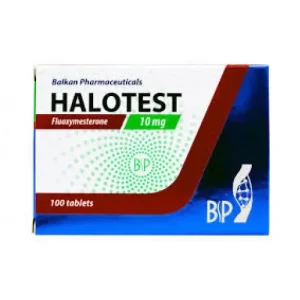Steroids
Post-Cycle Therapy (PCT): Is It Necessary?
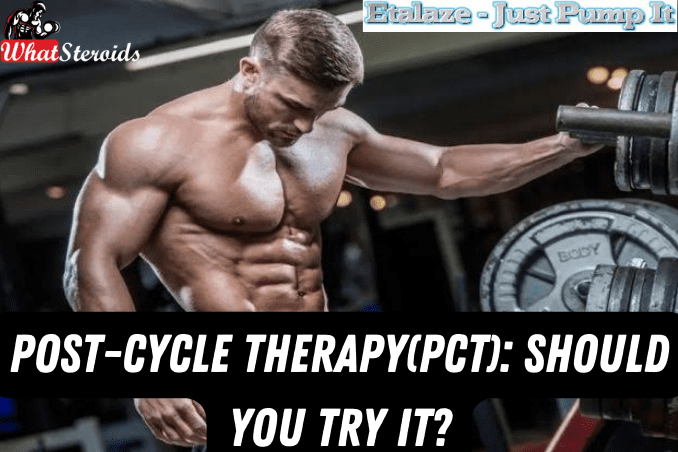
Post cycle therapy (PCT) is an essential aspect of the bodybuilding process, particularly for professional bodybuilders. PCT helps to restore hormonal balance and minimize potential side effects after a cycle of anabolic steroid use. There are several types of PCT protocols available, each with its own unique approach and benefits.
If you are asking yourself how steroids are used, you’ve come to the right place. First of all, what are steroids? Steroids are synthetic compounds which are used to enhance the body strength or in other words, it can be used to improve the overall performance of the human body. Steroid users are usually professional bodybuilders, but amateur athletes also use them.
No matter which group you belong to, you must know the basic rules of using the steroids. Steroids are used in cycles, and each cycle lasts differently depending on the type of steroid combination you’re taking. After each cycle, its usual to ‘’take’’ the post cycle therapy (or PCT).
What is Post Cycle Therapy (PCT)?
Post cycle therapy is very important and it shouldn’t be avoided because PCT helps our body to preserve the results created by the steroid usage period. Steroids have a big influence on our organism, and people who are taking them shouldn’t stop using them suddenly.
The body needs time to adjust both to starting and stopping of usage. If this is not respected, then the body can easily fall into a state of shock which is medically called post cycle or hormonal crash. In order to prevent this, the PCT is a necessary part of your steroid usage.
Must Read: What is PCT and Why It’s so Important in Steroid Cycles
It is important to note that PCT protocols should not be taken lightly, as improper or inadequate post-cycle recovery can lead to hormonal imbalances and other health complications. Prioritize your well-being by seeking professional guidance and adhering to recommended PCT practices.
PCT causes different reactions within different people due to:
- Lasting of the cycle
- Type of the steroids used
- Characteristics of the individual person’s body and organism.
Wrong Opinions On Post Cycle Therapy
It’s absolutely normal to have different opinions within many people, but what’s surprising is that many professional bodybuilders don’t know and can’t distinguish what is good and what is bad for them. This is because many of them are not completely familiarized with the process of steroids use.
Must Read: Golden Rules of Steroids Use
Many of them think that steroid usage simply consists of taking the steroids (like ordinary medicines) in some particular time of the day. But this is not true. Steroids are everything but ordinary. They have a big impact on our health. The biggest influence they have is on the endocrine system and if you are not ready to take the risks of using them, you should reconsider your decision.
The Truth About PCT, Benefits, Dos and Don'ts
Post cycle therapy (PCT) plays a crucial role in the world of bodybuilding, helping athletes maximize the benefits of their cycles and maintain optimal health. PCT refers to a period of time following the use of anabolic steroids or performance-enhancing drugs, where specific strategies are implemented to restore hormonal balance and minimize potential side effects.
One of the primary benefits of PCT is its ability to help bodybuilders retain their hard-earned gains while minimizing muscle loss. After completing a cycle, the body's natural testosterone production may be suppressed, leading to a decline in muscle mass and strength. By implementing an effective PCT regimen, bodybuilders can support their body's natural testosterone production and prevent muscle catabolism.
Developing great PCT strategies involves careful planning and consideration. It typically includes the use of various medications or supplements that aid in restoring hormonal balance. These may include selective estrogen receptor modulators (SERMs) like tamoxifen or clomiphene citrate, which help block estrogen receptors and stimulate natural testosterone production.
During PCT, there are certain dos and don'ts that should be followed for optimal results. It is essential to adhere to recommended dosages and follow specific protocols as advised by healthcare professionals or experienced individuals in the field. Additionally, maintaining a healthy lifestyle with proper nutrition, hydration, sleep, and exercise is crucial during this period.
Timing is also critical when it comes to PCT. The best time to start PCT depends on factors such as the compounds used during the cycle and their half-lives. Generally, it is recommended to begin PCT once exogenous hormones have cleared out from the system sufficiently.
Buying Post Cycle Therapy Steroids
Many people who are not well informed just go and buy some type of steroids and start using them. This is not the way it should be done! The doctor is the one and the only person who is capable of deciding which steroids are the best for you. Another illusion connected to the steroids is that you can just stop using them and there will be no consequences. But this is wrong.
Steroid cycles are planned in a way that the amount of steroid intake is slowly decreased as you are getting closer to the end of the cycle. If you suddenly stop using them, your organism will suffer a hormonal shock which can seriously damage your organs and your overall health. This is why proper cycle treatment and post cycle therapy is needed.
Post cycle therapy helps the body to recover from steroid use and to preserve the results you’ve gained. PCT is really useful and that’s why it has become a standard in terms of the use of steroids. PCT is extremely useful when it comes to long cycle treatments. It can help your body to recover the hormones more quickly.
PCT Protocols to Start With
When it comes to selecting a specific PCT protocol, it is crucial to consult with your trainer so they can tailor the regimen based on individual needs and goals. The duration and dosage of each medication may vary depending on factors such as the length and intensity of steroid use.
1. Selective Estrogen Receptor Modulators (SERMs)
SERMs such as Tamoxifen (Nolvadex) and Clomiphene (Clomid) are commonly used in PCT. These medications work by blocking estrogen receptors in certain tissues, thereby preventing estrogen-related side effects like gynecomastia. They also stimulate the production of luteinizing hormone (LH), which helps to kickstart natural testosterone production.
2. Aromatase Inhibitors (AIs)
AIs like Anastrozole (Arimidex) are often used during PCT to control estrogen levels. Unlike SERMs, AIs work by inhibiting the conversion of testosterone into estrogen, effectively reducing overall estrogen levels in the body.
3. Human Chorionic Gonadotropin (hCG)
hCG is a hormone that mimics luteinizing hormone and stimulates testosterone production in the testes. It is commonly used during PCT to help restore natural testosterone levels more rapidly.
4. Natural Testosterone Boosters
Some bodybuilders opt for natural testosterone boosters during their PCT instead of pharmaceutical interventions. These supplements typically contain ingredients like Tribulus Terrestris or D-Aspartic Acid, which claim to enhance natural testosterone production.
How Long does It Last?
The doctor’s job is to recommend the practice of post cycle therapy, but the final decision is up to you. No one can force you to take neither steroids nor PCT. But, if you decide not to take it, then it’s your responsibility to look out for the serious consequences you can suffer. If you decide otherwise, again, you shouldn’t take it on your own. The PCT combination and the duration of the PCT depend on the types of steroids you’ve used and the duration of the steroid usage cycle.
Steroids
Creatine vs Myostatin: An Expert’s Analysis
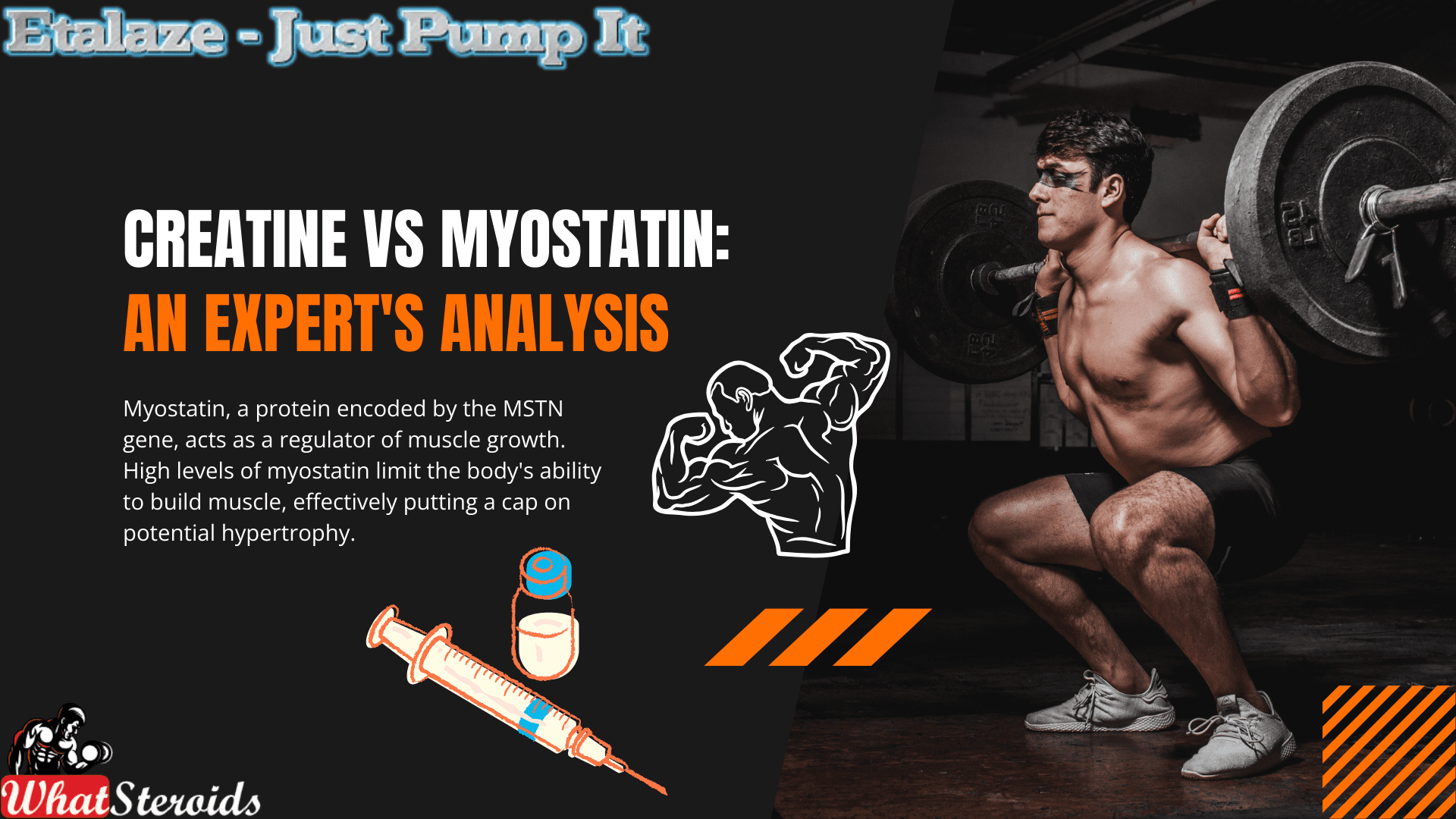
Myostatin, a protein encoded by the MSTN gene, acts as a regulator of muscle growth. High levels of myostatin limit the body's ability to build muscle, effectively putting a cap on potential hypertrophy. Inhibiting myostatin has become a focal point for bodybuilders looking to break through plateaus and achieve significant muscle gains. The question is: can creatine, a popular and widely available supplement, help in this regard?
Medical History of Myostatin and Creatine
Myostatin and creatine, while popular now in the bodybuilding world, have their roots in entirely different contexts:
Myostatin: Natural Muscle Growth Regulator
Myostatin is a protein originally identified for its role in regulating skeletal muscle mass. In nature, it serves an evolutionary purpose: by limiting muscle growth, it conserves energy, ensuring that animals (and humans) don’t expend unnecessary resources maintaining excessive muscle tissue. This was especially important in the wild, where energy efficiency could mean the difference between survival and extinction.
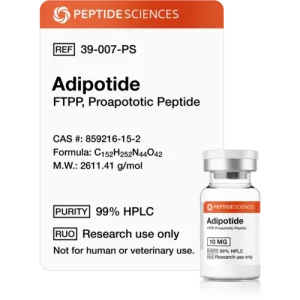 Check Adipotide (FTPP) 10mg by Peptide Science
Check Adipotide (FTPP) 10mg by Peptide Science
In the medical field, research into myostatin has focused on its role in muscle-wasting diseases. Scientists are exploring ways to inhibit myostatin to treat conditions like muscular dystrophy, where excessive muscle loss impairs quality of life. This therapeutic potential is where the idea of myostatin inhibition first began—long before bodybuilders latched onto the concept.
Creatine: Energy and Medical Applications
Creatine was originally studied for its role in energy metabolism. It’s a naturally occurring compound stored in muscle cells and plays a critical part in replenishing ATP (adenosine triphosphate), the body’s primary energy currency during short, high-intensity activities.
Before becoming a bodybuilding staple, creatine gained recognition in medical and sports science for its ability to improve athletic performance and assist with recovery. Furthermore, in medicine, creatine was investigated for neurological conditions such as Parkinson’s disease, Huntington’s disease, and muscular dystrophy, given its potential to improve muscle function and brain energy metabolism.
In the sports world, it was initially adopted by sprinters and weightlifters in the 1970s and 1980s for its energy-enhancing benefits.
Both myostatin and creatine have found new life in bodybuilding circles, demonstrating how discoveries in natural physiology and medical science can lead to transformative applications in fitness.
Benefits of Creatine as a Myostatin Inhibitor
Muscle Growth Potential: Research suggests that creatine, when paired with intense resistance training, may inhibit myostatin to a degree, fostering an environment for enhanced muscle growth.
Improved Exercise Performance: Creatine is well-known for its ability to increase ATP production, translating to better performance during high-intensity activities.
Versatility Across Fitness Levels
Whether you're a beginner or an advanced athlete, creatine offers benefits that complement various stages of muscle-building.
Must Read: A New Caffeine? What You Need to Know about Teacrine
Affordability and Accessibility
Compared to specialized myostatin inhibitors like YK-11 and ACE-031, creatine is significantly more affordable and accessible.
Side Effects of Creatine
While generally safe for most individuals, creatine supplementation does come with some potential side effects:
Water Retention: Some users experience bloating due to increased water retention in muscle cells.
Gastrointestinal Issues: High doses may lead to stomach upset or diarrhea.
Kidney Concerns: Although rare, prolonged excessive use could strain the kidneys, particularly in individuals with pre-existing conditions.
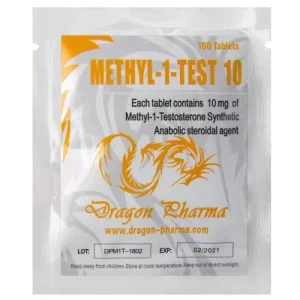 Buy Methyl-1-Test 10 -100 tabs by Dragon Pharma
Buy Methyl-1-Test 10 -100 tabs by Dragon Pharma
Alternatives to Creatine for Myostatin Inhibition
YK-11: A synthetic myostatin inhibitor derived from SARMs, offering more potent results but accompanied by more significant risks.
ACE-031: A peptide that directly inhibits myostatin, though it remains in experimental phases and is not legally approved in many regions.
Natural Alternatives
Follistatin-rich Foods: Eggs and dairy products may have natural myostatin-inhibiting properties.
Resistance Training: Intense and consistent weightlifting alone can naturally lower myostatin levels.
Where to Buy Creatine
Creatine is readily available worldwide. It can be purchased from:
Local Pharmacies and Nutrition Stores: Ideal for trusted and immediate access.
Online Platforms: Websites like Amazon, iHerb, or bodybuilding-specific stores offer a variety of brands and formulations.
Supplement Brands: Well-established brands such as Optimum Nutrition, MyProtein, and Cellucor often carry high-quality creatine.
Legality of Myostatin Inhibitors
Creatine: Creatine is completely legal and widely accepted as a dietary supplement.
YK-11 and ACE-031: These compounds exist in a legal gray area in many countries due to their experimental nature and potential risks. It's essential to research local laws before considering these options.
Best Stores and Suppliers
For reputable products, consider:
Transparent Labs: Known for purity and transparent labeling.
Optimum Nutrition: Offers pharmaceutical-grade creatine monohydrate.
Bulk Supplements: A great choice for bulk buyers seeking affordability and quality.
Our Advice to Bodybuilders
Always consult with a healthcare professional before starting any new supplement, especially if you are already using AAS or other advanced compounds.
Prioritize a balanced diet and consistent exercise routine. Supplements like creatine work best as part of a holistic approach to fitness.
Stay hydrated while using creatine to minimize water retention side effects and support kidney health.
Related Article: Best Syringes for Steroid Injection on Amazon
Overall
While creatine may not be as potent a myostatin inhibitor as advanced compounds like YK-11 or ACE-031, its affordability, safety, and accessibility make it a valuable addition to any bodybuilder's supplement stack. By leveraging its benefits alongside proper training and nutrition, you can maximize muscle growth and overcome plateaus, regardless of your fitness level.
Steroids
Raloxifene (Evista) 101: A Non-Surgical Solution for Gyno
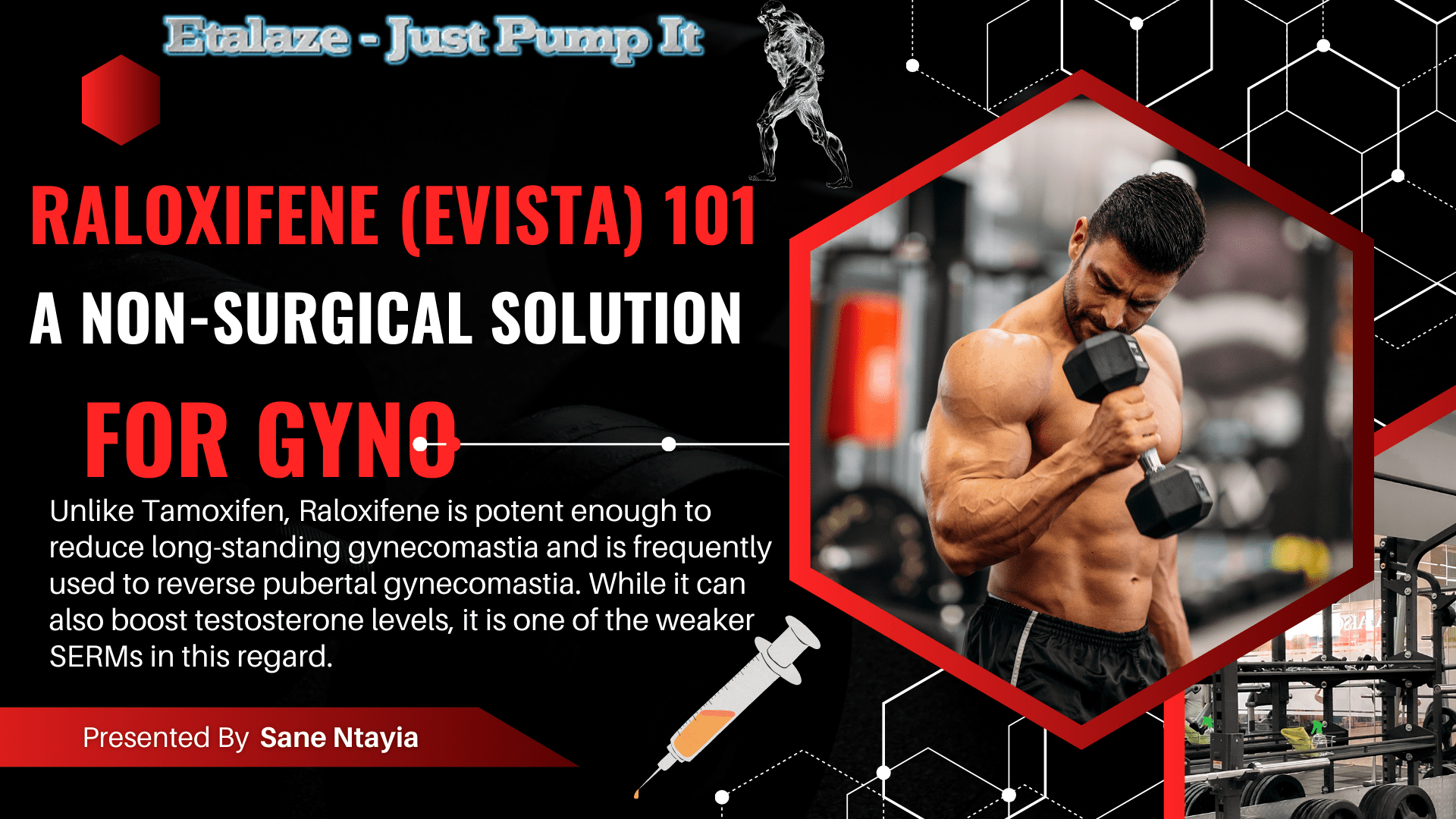
Raloxifene, a selective estrogen receptor modulator (SERM), is one of the most valuable yet less common options available today. Originally developed to prevent and treat breast cancer similar to Tamoxifen, it has gained popularity among bodybuilders seeking to prevent or eliminate gyno.
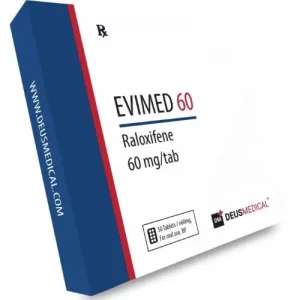 Click Here to Buy Evimed 60 by Deus Medicals
Click Here to Buy Evimed 60 by Deus Medicals
Unlike Tamoxifen, Raloxifene is potent enough to reduce long-standing gynecomastia and is frequently used to reverse pubertal gynecomastia. While it can also boost testosterone levels, it is one of the weaker SERMs in this regard.
How it Works
Raloxifene functions by blocking estrogen receptors in the breasts, which helps prevent or treat both gynecomastia and breast cancer. Additionally, it blocks estrogen receptors in the hypothalamus, stimulating testosterone production.
Beyond these primary benefits, Raloxifene can enhance bone mass, combat osteoporosis, and lower cholesterol levels.
Potential Side Effects
While Raloxifene is considered a generally safe and effective medication, like all drugs, it comes with its own set of potential side effects. One of the most notable is the reduction in Insulin-like Growth Factor 1 (IGF-1) levels. IGF-1 plays a key role in muscle growth and repair, so decreased levels could potentially impact athletic performance or recovery.
However, compared to other medications in its class, Raloxifene has a relatively low risk of causing severe liver toxicity. Users are less likely to experience harmful effects such as blood clots, mood swings, or sexual dysfunction, making it a preferable choice for many.
While rare, some users might experience less serious side effects such as hot flashes, leg cramps, or flu-like symptoms. It's essential to consult with a healthcare professional to monitor any adverse reactions and ensure the medication is being used safely.
So, despite its efficacy, Raloxifene is not without side effects, but they are typically manageable and less severe compared to other SERMs.
Check Out Halotest 10 mg, Balkan Pharmaceuticals
For gyno reversal, the typical protocol involves taking 60mg daily for 1-2 weeks, followed by 30mg daily for up to 3 months or until the condition resolves.
Read More: Joint Stiffness on AAS, How to Manage It
Typical Protocol
For gynecomastia reversal, the typical protocol involves taking 60mg of Raloxifene per day for 1-2 weeks, followed by a reduced dose of 30mg per day for up to 3 months or until the gynecomastia is resolved. In post-cycle therapy (PCT), bodybuilders generally take 60mg per day for 4-6 weeks, and then lower the dose to 30mg per day during the last week. Raloxifene is highly effective for managing gynecomastia and supporting post-cycle recovery, making it a valuable addition to a well-optimized bodybuilding regimen.
Overall
Raloxifene (Evista) is a versatile SERM used to treat breast cancer and is popular among bodybuilders for managing gynecomastia (gyno). Unlike Tamoxifen, it effectively shrinks long-standing gyno and reverses pubertal gyno. It blocks estrogen receptors in the breast and hypothalamus, thus preventing gyno and promoting Testosterone secretion. Additionally, it improves bone mass, combats osteoporosis, and lowers cholesterol levels. For gyno, take 60mg/day for 1-2 weeks, then 30mg/day for up to 3 months. For post-cycle therapy (PCT), take 60mg/day for 4-6 weeks, then reduce to 30mg/day during the final week. This safe and effective medication has minimal side effects.
Bodybuilding
Mastering Bodybuilding in 2025: Top Fitness Tips for Success

Bodybuilding is more than just a sport; it's a lifestyle that requires dedication, discipline, and a thorough understanding of fitness principles. As the world of fitness continues to evolve, bodybuilders must stay updated with the latest trends, techniques, and scientific advancements to achieve their goals. In 2025, several innovative approaches are redefining bodybuilding. Here are essential fitness tips for bodybuilders to excel this year.
Read More: Bodybuilder Winter Clothing: Staying Warm and Stylish
Embrace Technology-Driven Workouts
In 2025, technology plays a significant role in bodybuilding. Wearable devices, fitness apps, and virtual reality (VR) training are now integral components of an effective workout regimen.
Wearable Devices
Modern wearables track everything from heart rate and sleep patterns to muscle activation and caloric expenditure. Utilize these devices to monitor your progress and make data-driven adjustments to your training and nutrition plans.
Fitness Apps
Leverage fitness apps for customized workout plans, progress tracking, and virtual coaching. Many apps now incorporate artificial intelligence to provide personalized feedback and recommendations.
Virtual Reality Training
VR technology offers immersive workout experiences, allowing bodybuilders to simulate different training environments and scenarios. This can enhance motivation and add variety to your routine.
Focus on Functional Strength
While hypertrophy (muscle growth) remains a primary goal, functional strength is gaining importance. Functional strength training improves overall performance, reduces the risk of injury, and enhances daily activities.
 Check Out Our1 4 Weeks Quality Strength & Lean Muscles
Check Out Our1 4 Weeks Quality Strength & Lean Muscles
Compound Movements
Incorporate compound exercises like squats, deadlifts, and bench presses. These movements engage multiple muscle groups and joints, promoting balanced strength development.
Core Stability
Prioritize exercises that strengthen the core, such as planks, Russian twists, and leg raises. A strong core supports better lifting mechanics and reduces the risk of lower back injuries.
Optimize Nutrition for Muscle Growth and Recovery
Nutrition is the cornerstone of successful bodybuilding. In 2025, the focus is on personalized nutrition plans tailored to individual needs and goals.
Protein Intake
Ensure adequate protein intake to support muscle repair and growth. Aim for 1.6 to 2.2 grams of protein per kilogram of body weight per day, depending on your training intensity and goals.
 Click Here to Buy SynthaTrope By SynthaPharma
Click Here to Buy SynthaTrope By SynthaPharma
Nutrient Timing
Pay attention to nutrient timing to maximize muscle recovery and growth. Consume protein and carbohydrates within 30 minutes post-workout to replenish glycogen stores and kickstart muscle repair.
Supplements
Utilize supplements wisely. Creatine, branched-chain amino acids (BCAAs), and omega-3 fatty acids are popular choices for enhancing performance and recovery.
Prioritize Mental Health and Mindfulness
Mental health is increasingly recognized as a critical component of overall fitness. Incorporating mindfulness practices can improve focus, reduce stress, and enhance performance.
Meditation
Incorporate meditation into your daily routine to reduce stress and improve mental clarity. Mindfulness meditation can enhance your mind-muscle connection during workouts.
Visualization
Use visualization techniques to mentally rehearse your workouts. Visualizing successful lifts and achieving your goals can boost confidence and motivation.
Rest and Recovery
Prioritize rest and recovery to prevent burnout and overtraining. Ensure you get 7-9 hours of sleep per night and incorporate rest days into your training schedule.
Leverage Advanced Training Techniques
Advanced training techniques can help break through plateaus and stimulate muscle growth. In 2025, several methods are gaining popularity among bodybuilders.
Blood Flow Restriction (BFR) Training: BFR involves restricting blood flow to the muscles during low-intensity exercises. This technique can enhance muscle growth and strength without the need for heavy weights.
Eccentric Training: Focus on the eccentric (lowering) phase of exercises. Eccentric training can stimulate greater muscle damage and growth compared to traditional concentric movements.
Periodization: Implement periodization into your training plan. Varying the intensity, volume, and type of exercises can prevent plateaus and ensure continuous progress.
Incorporate Recovery and Mobility Work
Recovery and mobility are essential for preventing injuries and maintaining optimal performance. In 2025, bodybuilders are paying more attention to these aspects of training.
Foam Rolling and Myofascial Release: Use foam rollers and massage balls to release muscle tightness and improve flexibility. Regular myofascial release can reduce soreness and enhance recovery.
Stretching: Incorporate dynamic stretching before workouts and static stretching after workouts. Stretching improves range of motion and prevents muscle imbalances.
Cryotherapy and Hydrotherapy: Explore recovery techniques like cryotherapy (cold therapy) and hydrotherapy (water therapy) to reduce inflammation and accelerate muscle recovery.
Engage in Continuous Learning and Community Building
The fitness industry is constantly evolving, and staying informed is crucial for success. Engage in continuous learning and connect with the bodybuilding community for support and motivation.
Educational Resources: Read books, watch videos, and attend seminars to stay updated on the latest research and trends in bodybuilding.
Community Engagement: Join online forums, social media groups, and local bodybuilding clubs. Sharing experiences and knowledge with fellow bodybuilders can provide valuable insights and encouragement.
Professional Guidance: Consider working with a certified personal trainer or coach. Professional guidance can help you optimize your training and nutrition plans, ensuring you're on the right track.
With your FB Plus subscription or active FB Plus Pass, you now have access to 124 weeks of our most popular workout programs, which typically sell for $10-$30 each. Additionally, our popular 4-week Meal Plan is included. This is on top of the 38 Challenges and Programs that are already available to Plus members.
We've also introduced a new feature that many of you have requested. To assist you in choosing your next program, you can now preview each day of any program from its detail view. This feature lets you see all the included workout videos and content before you schedule it, ensuring you know exactly what to expect.
Conclusion
In 2025, bodybuilding is more than just lifting weights; it's a holistic approach to fitness that encompasses technology, nutrition, mental health, and advanced training techniques. By embracing these fitness tips, bodybuilders can achieve their goals, stay injury-free, and enjoy a fulfilling fitness journey. Remember, consistency and dedication are key to success in bodybuilding. Stay committed, keep learning, and most importantly, have fun on your path to becoming the best version of yourself.
-

 Steroids2 years ago
Steroids2 years agoVOX Testing: Why Bodybuilders Must Have It Tested Regularly
-

 Steroids2 years ago
Steroids2 years agoShavers and Other Body Grooming Equipment for Bodybuilders In 2023
-

 Steroids2 years ago
Steroids2 years agoChatGPT and Other Avenues to Find Great Bodybuilding Coaches
-

 Steroids2 years ago
Steroids2 years agoBest Oil Recommendations Before Competition for Subtle Shimmer
-

 Steroids2 years ago
Steroids2 years agoPowerlifting Vs Power Building: Find Out the Big Difference and When to Shift Between the Two
-

 Nutrition1 year ago
Nutrition1 year agoEverything Nutritional Food: What’s Too Much Or Too Little
-

 Bodybuilding Products12 months ago
Bodybuilding Products12 months agoTelmisartan In Bodybuilding: An Expert’s Advice
-

 Anabolic Steroids1 year ago
Anabolic Steroids1 year agoLegality of Anabolic Steroids In Latin America
-

 Beginners2 years ago
Beginners2 years agoTren Cycle for Beginners
-

 Bodybuilding1 year ago
Bodybuilding1 year agoList of FDA-Approved Peptides
-

 Bodybuilding2 years ago
Bodybuilding2 years agoCompetition Prep Cycle for Pro Bodybuilders
-

 Bodybuilding1 year ago
Bodybuilding1 year agoChia Seeds in A Bodybuilder’s Diet: An Expert’s Advice
-

 Anabolic Steroids11 months ago
Anabolic Steroids11 months agoHow Much Do You Know About B-AET? A Fat Burner You’ve Been Missing
-

 Bodybuilding7 months ago
Bodybuilding7 months agoPrimal Movements: Our Ultimate Guide for Maximum Results
-

 Steroids11 months ago
Steroids11 months agoAnadrol Cycle: Benefits, Doses, Alternatives, etc.
-

 Anabolic Steroids8 months ago
Anabolic Steroids8 months agoJoint Stiffness: How to Manage It While on AAS
-

 Steroids9 months ago
Steroids9 months agoOmnitope (Oxytocin)
-

 Product Reviews10 months ago
Product Reviews10 months agoTop Vitamins for Skin Health
-

 Bodybuilding1 year ago
Bodybuilding1 year agoHow Much Is Too Much Cardio? Understanding Heart Rate Zones
-

 Bodybuilding8 months ago
Bodybuilding8 months agoHow Effective is Bone Broth for Recovery?
-

 Steroids10 months ago
Steroids10 months agoMajor Bodybuilding Peptides Explained
-

 Steroids8 months ago
Steroids8 months agoSleeping Positions for Effective Muscle Recovery
-
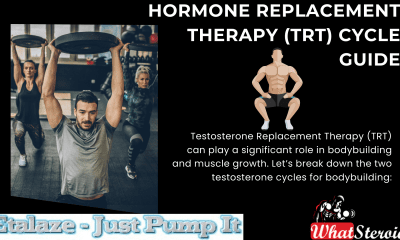
 Bodybuilding9 months ago
Bodybuilding9 months agoHormone Replacement Therapy (TRT) Cycle Guide
-

 Anabolic Steroids1 year ago
Anabolic Steroids1 year agoStart The New Year Strong With These Tips
-

 Bodybuilding1 year ago
Bodybuilding1 year agoCalorie Dumping: A Bodybuilder’s Guide





